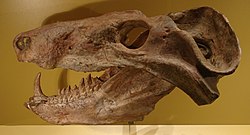This article needs additional citations for verification .(September 2020) |
| Cynognathians Temporal range: Early to Late Triassic, | |
|---|---|
 | |
| Skull of the carnivorous cynognathian Cynognathus crateronotus | |
 | |
| Skull of Exaeretodon a herbivorous traversodontid | |
| Scientific classification | |
| Domain: | Eukaryota |
| Kingdom: | Animalia |
| Phylum: | Chordata |
| Clade: | Synapsida |
| Clade: | Therapsida |
| Clade: | Cynodontia |
| Clade: | Eucynodontia |
| Clade: | † Cynognathia Hopson and Barghusen, 1986 |
| Subgroups | |
| |
Cynognathia ("dog jaw") is one of two major clades of cynodonts, the other being Probainognathia. Cynognathians included the large carnivorous genus Cynognathus and the herbivorous or omnivorous gomphodonts such as traversodontids. Cynognathians can be identified by several synapomorphies including a very deep zygomatic arch that extends above the middle of the orbit.
Contents
Cynognathian fossils are currently known from Africa, Antarctica, Asia, Europe, North America and South America.

